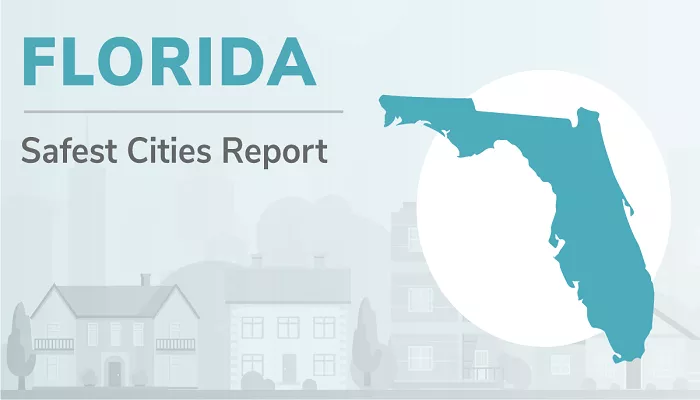Florida attracts millions with its warm climate and beautiful beaches, but safety remains a top concern for residents. Based on crime statistics, natural disaster risks, and community factors, these seven Florida communities stand out as the safest places to live in 2025. As a geographer who has studied Florida’s diverse landscapes, I’ll analyze what makes each location uniquely secure.
1. Weston (South Florida)
Safety Highlights
- Violent crime rate: 86% lower than Florida average
- Property crime rate: 62% below state average
- Hurricane protection: 15 miles inland from Fort Lauderdale
Community Advantages
- Master-planned community with 24/7 security patrols
- Excellent schools (A-rated district)
- 700+ acres of parks and nature preserves
Economic Factors
- Median household income: $122,000
- Major employers: Cleveland Clinic, Ultimate Software
- 3.2% unemployment rate (below state average)
2. Parkland (Broward County)
Safety Highlights
- #1 Safest City in Florida (2024 SafeWise Report)
- Flood risk: Low (elevation 15-20 feet above sea level)
- Emergency response time: Under 5 minutes
Unique Features
- Rural character with urban access
- 55% tree canopy coverage
- Active neighborhood watch programs
Cultural Aspects
- Family-oriented community events
- High volunteer participation
- Award-winning public library
3. Marco Island (Southwest Coast)
Safety Highlights
- Violent crime rate: 0.7 per 1,000 residents
- Storm-resistant infrastructure: Post-Ian upgrades
- Marine patrol: 24-hour water safety monitoring
Coastal Advantages
- Advanced flood warning systems
- Strict building codes (170+ mph wind rating)
- Elevated roadways in flood zones
Tourism Balance
- Seasonal population management
- Gated residential communities
- Limited late-night venues
4. Winter Springs (Central Florida)
Safety Highlights
- Year-over-year crime decrease: 11%
- Wildfire protection: Class 1 ISO fire rating
- Traffic safety: Fewest accidents per capita in region
Geographic Benefits
- Protected from coastal storms
- Stable limestone foundation
- Multiple evacuation routes
Community Investments
- New smart policing technology
- Neighborhood emergency preparedness groups
- Senior safety initiatives
5. Palm Coast (Northeast Florida)
Safety Highlights
- Lowest hurricane risk on Florida’s east coast
- Flood prevention: 125 miles of managed canals
- Pedestrian safety: Award-winning trail system
Nature Protection
- 7,000+ acres of conservation land
- Fire-adapted community planning
- Saltwater intrusion monitoring
Affordable Safety
- Median home price: $350,000
- Low property insurance rates (for Florida)
- Growing job market in healthcare/tech
6. Niceville (Panhandle)
Military-Grade Security
- Neighboring Eglin Air Force Base presence
- Crime rate: 70% below state average
- Emergency preparedness: Military-coordinated drills
Natural Advantages
- Protected harbor location
- Stable clay soils (reduces sinkhole risk)
- Abundant freshwater springs
Quality of Life
- Top-rated school system
- 98% resident satisfaction rate
- Active community wellness programs
7. Key Biscayne (Miami-Dade)
Urban Safety Model
- Island security: Limited access points
- Beach safety: Lifeguards at all public beaches
- Cyber safety: Municipal fiber network with robust protections
Coastal Adaptations
- Elevated power infrastructure
- Artificial reef storm protection
- Continuous dune restoration
Cultural Safety
- Multilingual emergency alerts
- Active hurricane preparedness culture
- Community emergency response teams
Analysis: What Makes These Locations Safe?
Common Safety Factors
- Proactive policing strategies
- Enforced building codes
- Controlled community growth
- Emergency preparedness culture
- Geographic advantages
Regional Safety Patterns
- South Florida: Master-planned communities excel
- Central Florida: Inland locations avoid worst storms
- Panhandle: Military presence enhances security
- Coastal areas: New infrastructure investments pay off
Safety Considerations for Potential Residents
Natural Disaster Preparedness
- Hurricane readiness: All communities have robust plans
- Flood zones: Verify specific property risks
- Climate adaptation: Check local resilience projects
Personal Safety Tips
- Research neighborhood-specific crime maps
- Review community emergency response times
- Verify homeowner’s association safety provisions
- Check sex offender registry locations
- Evaluate hospital access and quality
Future Safety Trends to Watch
Emerging Technologies
- AI-powered crime prediction
- Smart home security integration
- Drone-based emergency response
Climate Adaptation
- Rising insurance requirements
- Evolving building materials
- Managed retreat planning
Demographic Shifts
- Senior-focused safety services
- Multilingual emergency communications
- Remote worker security needs
Conclusion
These seven communities demonstrate that Florida offers exceptional safety without sacrificing quality of life. Whether you prefer coastal living in Marco Island, suburban security in Weston, or military-protected Niceville, Florida’s safest cities combine geographic advantages with smart planning. As climate and population changes continue, these communities are best positioned to remain safe havens in the Sunshine State.

